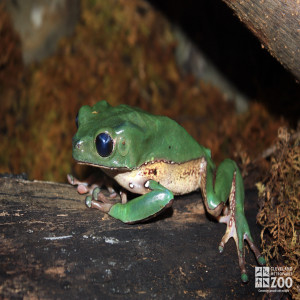Giant Waxy Tree Frog
[Dendrobates azureus]

The Giant Waxy Tree Frog has a slim body with a rounded snout. It has slender legs with toes and fingers having small adhesive discs for climbing when necessary. They have four toes per foot, each with a wide, flattened tip and a suction cup pad to help grip.
The frog is less than two inches long and has no teeth. Its color, bright blue with black dots on its back and a light stomach, alerts potential predators that its skin holds a poisonous liquid which is unpleasant to the taste. The alkaloid poisons are capable of paralyzing and even killing predators. Males and females appear quite similar.
Location: Animals Formerly at Zoo
Share:
Range
The range of the Giant Waxy Tree Frog is South America: the Sipaliwini savannah of southern Surinam near the border with Brazil.
Habitat
The Giant Waxy Tree Frogs inhabit drier forest islands within the Rain forest near smaller streams.
Conservation Status
Least ConcernPrimary Threats
Gestation
Giant Waxy Tree Frogs lay eggs which hatch into tadpoles in about 18 days. They change into frogs 10 to 12 weeks later through metamorphosis.
Litter
Clutch size: Four to six eggs
Behavior
Giant Waxy Tree Frogs are active during the day, foraging in the leaf litter for their food. They move in short hops and are rarely still for more than a few moments.These frogs are solitary except for fighting and breeding. They are territorial, and will settle territorial disputes by having "wrestling matches".
Reproduction
Mating in Giant Waxy Tree Frogs is done during the rainy season by amplexus in which the male clasps the female while she lays her four to six eggs. He fertilizes these immediately after they are expelled before the jelly that surrounds them swells. All eggs are laid on the ground and are guarded by the parents until they become larvae. The male then attaches the larvae to his back by a mucous secretion and carries them to a small pool of water. Here they develop into tadpoles and eventually into frogs through metamorphosis. (Females have been observed fighting aggressively over males; the winner then begins the courtship.)
Wild Diet
Ants, termites and other small Arthropods (spiders, insects)
Zoo Diet
Fruit flies and crickets
